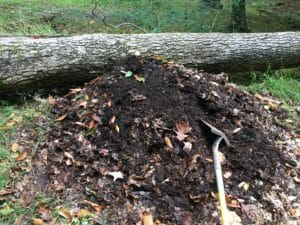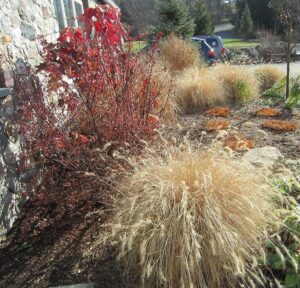Hello fellow readers, It’s the fall garden wrap up time, and I tended to some over the weekend. It feels good to be ahead of my usual scramble when the first snowflakes fly. Some fall garden wrap- up tasks, such as cleaning up perennials, may seem obvious. But others, like fall fertilizing, can be confusing. Here are a few simple tips.
Cutback some perennials and keep others for winter interest.
Cutting back dry or yellowing perennial foliage is a fall to-do. However, I enjoy keeping some standing dry for winter interest, such as ornamental grasses and certain perennials with seed heads that look lovely dry. This year though, I cut back the overly zealous coneflower (echinacea) and black-eyed Susan (rudbeckia). I placed the seed heads in areas where ambitious volunteers are welcome and feathered friends can have first dibs.
I cut back the bulk of the butterfly bush branches to prevent self-seeding, keeping some of the starbursts of new growth to enjoy through fall. Come Spring, I’ll finish the rejuvenation pruning by cutting them down to about six inches. Butterfly bush can be invasive, though I find volunteers primarily find their way in gravelly and rocky soil and not typically in garden beds. There are new seedless or non-invasive varieties such as Buddleia x ‘Miss Molly’ ‘Miss Violet’ ‘Miss Ruby,’ and ‘Miss Pearl.’
Fall Fertilizing with Leaf Mold or Organic Supplements
Regarding fall fertilizing, I always coached folks not to fertilize when installing or transplanting as it can add further stress. Plants put energy into absorbing the added nutrients rather than overcoming the strain of being moved. But after they settle in, fertilizing will help encourage healthy root development.
I’m a fan of top-dressing garden beds with leaf mold in the fall. Leaf mold is composted leaves packed with minerals that fertilize the soil and help retain moisture and suppress weeds.
For those that use wood mulch, fertilizing garden beds and areas around shrubs and trees in the fall is wise as decomposing wood depletes the soil’s nitrogen. I suggest North County Organic’s Pro-Start 2-3-3 or other organic products that are similar. FYI– the three numbers represent fertilizer formulas. The first is the percentage of nitrogen, which promotes foliage growth. The second is phosphorus, which nurtures root development. The third number is potassium, also known as potash, to stimulate cell function to absorb nutrients.
In the Spring, I routinely spread an all-purpose fertilizer such as Pro-Gro 5-3-4, also by North Country, atop my leaf mold mulch, which you can also apply on top of wood mulch.
About Deep Root Fertilization
“What about root fertilizing,” asked John of Stone Church, PA? My associate arborist, Dave Dubee of Greenwood Tree & Lawn, suggests deep root fertilization in the Fall (or Spring) every twelve or eighteen months to help trees struggling from depleted soil or transplant shock. He injects an organic blend of nutrients and mycorrhizal fungi into the ground around the root zone using a long feeding needle.
The Critical Root Zone (CRZ) is the root area under the canopy drip line, the tree branches’ width. Although roots often grow two or three times wider than the CRZ. Getting the fertilizer directly to the roots, rather than applying it on the surface, prevents absorption by competing roots of other plants such as grass. The pressure used to inject the nutrients also helps to aerate the soil, improving compacted soils to allow oxygen and water to reach the roots.
It’s true that if we left fallen leaves in the garden and around our trees and shrubs, they would do the job of fertilizing as they decompose throughout the winter. So, why not leave some in your gardens to provide nourishment as nature intended—trusting Mother Nature is the best protocol of all.
Garden Dilemmas? AskMaryStone@gmail.com (and now on your favorite Podcast App.)
Click through to a previous column about Leaf Mold – Better than Mulch.
Link to North Country Organics





